Unfortunately, due to low use from 4thWay's website users, we rarely update these detailed Insight Reports any more. Please see our Quick Expert Reviews in 4thWay's P2P lending comparison tables and see our latest guides, articles and research by visiting our Learn page.
If you would really find it useful to have reports like this, or other detailed reports in another format, please get in touch. We are very interested in how we can present you with all the information you want and need – in the way you want it – to educate yourselves about P2P lending opportunities.
This report was last updated on 27 July, 2016, with some amendments on 22 September 2016
Our RateSetter review is again, more detailed, candid research from 4thWay's experts. RateSetter is a P2P lending website focusing mostly on unsecured consumer loans, but with a good number of business loans and even some property development loans thrown in. This is a mix that makes our experts' jobs of quantifying risks that little bit more interesting, but far from a first in our experience.
If you're looking for one aspect in particular, glance through the contents on the far right.
RateSetter review: interest rates and 4thWay® PLUS Ratings
When we're modelling RateSetter's risks at 4thWay, we separate the loans based on the type of lending and other parameters to better get a grasp of how it might perform, worst case, during a very severe recession. (We use the same international methods as the banks do, albeit we're much stricter than they are required to be.)
However, individual lenders on RateSetter do not get to choose who they lend to or what types of loans they want to lend in. So to lenders this rather more like an investment fund where you get a pot of loans. That's why we present the key information to you with all loan types “pooled” together. Rest assured though that we have adjusted our measurements based on the underlying risks in the different types of loans:
[supsystic-tables id='17']
*No lenders have suffered losses from these bad debts because RateSetter's reserve fund has covered them.
All RateSetter's lending products have been awarded 4thWay PLUS Ratings, which means we believe they are all investment-grade based on our highly conservative estimates using international banking (Basel) tests of whether and how swiftly lenders will recover their losses after a very severe, 1-in-100 year recession and, in the case of RateSetter's property development loans, a crash resulting in distressed sales 55% below the properties' initial values.
RateSetter has received either four or five PLUSes for each of its products, which are our top two ratings. Five PLUSes means we expect based on our strict modelling that lenders will either make no losses during those severe economic times or they will recover all their losses on their loans within two years, even if they stop lending and their loans wind down. Four PLUSes gives additional leeway to allow three years for for a full recovery, but it could well be less.
The 4thWay Risk Scores reflect our conservative estimate of the risk of losses during a very severe recession before taking into account any interest you might earn. A score of 1 is reserved for savings accounts and scores of 8-10 are around stock market risk. RateSetter's risk score of 4 means we expect losses of less than 5% losses before interest. The evenness of the scores across all RateSetter's products is because, in a severe disaster, RateSetter would pool all the loans together – effectively spreading everyone's risk proportionately against all outstanding loans.
Read about the 4thWay PLUS Ratings and Risk Scores. The PLUS Ratings and Risk Scores are indicators, not guarantees. They assume that you spread your money across lots of loans.
Key data points
[supsystic-tables id='19']
RateSetter’s highlights and lowlights
- Lenders on RateSetter have now earned £50 million without losing a penny, over £1,000 each, due to its mostly prime borrowers and large bad-debt fund, in over four years.
- RateSetter has a massive bad-debt provision fund to pay for defaults, so that your returns are steady through all except perhaps the worst years.
- In the event the bad-debt provision fund is overwhelmed by bad debts, all surplus bad debts will be split between all lenders, ensuring that you don't take the full hit of just a few bad loans.
- RateSetter is one of the older and larger P2P lending companies.
- You can usually exit loans almost immediately and at no cost, except to reimburse new lenders taking over your loans for any disadvantage they would otherwise have.
- A large number of borrowers and lenders also helps to ensure that you can lend quickly and exit easily by re-selling your loans.
- You receive monthly loan repayments and borrowers can repay all or part of their loans early. Your loan parts will then need to be re-lent.
- This P2P lending company has the most automation options available for lending, re-lending and withdrawing, saving you time and hassle.
- 98% or RateSetter users would recommend the company to a friend.
- The excitement level for RateSetter is low and the deal-making possibilities are zero, since you don’t know who your borrowers are and you cannot massively outperform other lenders through patient strategy or clever selection of borrowers.
- RateSetter is a member of the Peer-to-Peer Finance Association and maintains very high standards of transparency.
- Our extreme risk modelling shows even RateSetter's fat reserve fund being depleted in an extraordinarily bad recession, but this is easily offset by annual interest earned.
It takes a lot of time and money to produce high-quality research. Please link to this report, but if you want to re-use the thoughts, ideas or information within this 4thWay® Insight Report commercially, journalistically, in comparison tables or in a blog, please see our terms and conditions. We do not provide financial advice or guarantees. See the bottom of this report for some key terms and disclaimers.
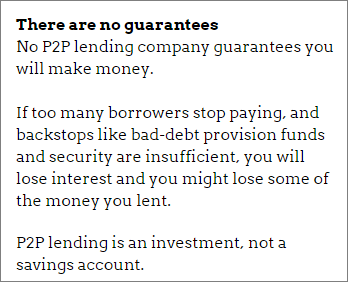 Who does RateSetter lend to?
Who does RateSetter lend to?
RateSetter mostly does consumer loans (approx. 60%-70%), which are relatively easy to measure the risks. RateSetter has the people and processes in place to properly score consumer borrowers, so that a large basket of loans is unlikely to lead to losses in almost any circumstances.
It also lends around 30% to businesses. While these loans are a little trickier, there is still a vast amount of data that enables good pricing of loans and RateSetter again has highly skilled underwriters and credit-risk experts with the appropriate experience.
RateSetter has also been dipping into property development properly now since early 2014. It accounts for around 10% of RateSetter's loans. Development lending is intrinsically high risk compared to most other forms of lending, since there is a lot that can happen between purchasing the land and completing the development, there is relatively little data to model risks on, and the loan sizes can often be high compared to the value of the existing land and property.
However, intrinsic risks can be controlled and even reduced to as low, or lower, than typical consumer or business loans. (For example, you can lend considerably less than the initial property is worth and lend to highly experienced developers. Another example is that a platform doing business lending can be lower risk than one doing consumer lending, because it lowers the risks through a disciplined approach to assessing borrowers.) RateSetter's record with property development shows that it is doing what it said it would: dipping in very cautiously, with strict borrower and property criteria to ensure that bad debts don't balloon.
About RateSetter's bad-debt rates
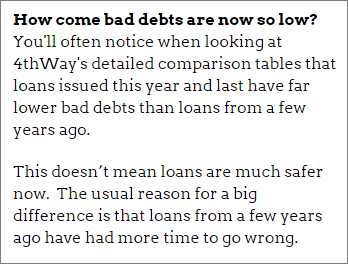 We're passed the halfway point in 2016, so it's a good time to reflect on how well the latest batch – the 2016 batch – of RateSetter loans is performing, to see whether RateSetter is keeping to its strict standards.
We're passed the halfway point in 2016, so it's a good time to reflect on how well the latest batch – the 2016 batch – of RateSetter loans is performing, to see whether RateSetter is keeping to its strict standards.
The bad debts for loans issued this year are broadly similar to the bad debts on loans issued in 2015, at around 0.3% of all the loans. We can loosely expect that if the economy stays moderate the total bad debts on loans issued in 2016 will rise to 2% to 3%. This is the entire bad debt on those loans, not the annual bad debt, so it will be spread over several years. This is low enough that, even if RateSetter had no reserve fund, one year's interest would be easily sufficient to cover those losses.
RateSetter lenders don't just lend in new loans though. They may be allocated loans from other people who are selling out, but beyond that, in an extreme crisis where the reserve fund is depleted, all loans are pooled so that all lenders are diversified proportionately across the tens of thousands of open loans.
The overall loan book has what we think is a satisfactory bad-debt rate of around 1.6% – in normal times – which is easily covered by RateSetters very large reserve fund. During a severe recession, the large increases in bad debts should be tolerated by lenders through the reserve fund and potentially a loss of some interest.
You can see more on RateSetter's bad-debt figures in the bad debts section of the detailed comparison tables.
We’re going to take a look at two key indicators of potential bad-debt trouble ahead: acceptance rates and arrears:
Acceptance rates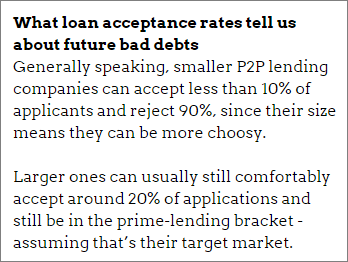
Rapid growth in the proportion of borrowers that RateSetter accepts could mean it is is relaxing its standards and moving towards sub-prime.
The numbers are reassuring. RateSetter currently accepts around 20% of applicants, which is within the region you would expect for a large P2P lending company with a focus on prime borrowers.
It is to RateSetter's particular credit that it shares this key information.
Arrears
4thWay® keeps track of RateSetter's arrears – late payments – to see if there are any increases that should give us cause for concern, particularly noting how those arrears compare to competitors in the same year. Currently, on this basis, we still see no signs that RateSetter is weakening it's very high standards.
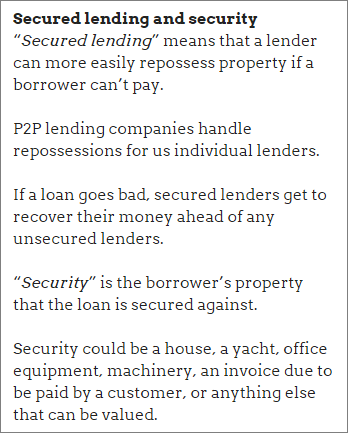 Security
Security
Most RateSetter loans are unsecured. RateSetter is incredibly transparent compared to most P2P lending platforms (and compared to most other investments). However, since we don't have quite enough information about the security that RateSetter takes on its secured loans (see info box to the right), we treat this peer-to-peer lending company's secured loans as “naked”, meaning we assume that the loans are worth more than the security. This is a worst-case scenario and the situation is probably considerably better than that. Despite this conservative approach, RateSetter still gets the top 4thWay PLUS Ratings due to its overall loan performance and history.
Interest rates and repayments
Interest rates at RateSetter have fallen recently so that they are now around about fair value, in our opinion, for the risks involved, with a large margin of safety still built in for severe recessions.
Previously rates were too high, we believe, largely due to lenders being more cautious about lending through RateSetter and in peer-to-peer generally.
That meant that borrowers needed to pay them more interest to entice them to lend. Not any more.
The rates RateSetter offers are based on the length of time you lend for. Longer loans give you higher interest rates.
You can lend for just one month and then roll it over into following months if you like, receiving monthly interest. If you lend for five years, you will also receive monthly loan repayments, including some of the money you lent plus some interest.
The one-year deal works a bit differently. You don’t get paid each month, but you get paid all your loan and interest at the end of the year instead. This is likely to do with the fact that those lending for one year will be allocated the bulk of the property development loans. Development borrowers typically pay their loans and interest in full at the end.
(But remember that in a serious disaster where the reserve fund is depleted your risks would be spread across all RateSetter loans, so one-year lenders will not just be stuck with all the higher-risk property development loans!)
You can set the individual interest rate you want to receive higher than those currently shown on the RateSetter website, although it will take you longer to get your money out on loan if there is not enough demand from borrowers. Priority goes to the lenders who set the lowest rates, even if you were earlier in the queue.
[supsystic-tables id='20']
*No losses have been made due to the RateSetter's reserve fund to cover expected losses. Interest rates are an average over the past two years.
Make sure you get maximum interest
Let’s take a closer look at one of your longer RateSetter lending options: lending for five years.
The official figure for five-year loans is currently around 6%, although this is assuming 1) you re-lend the repayment you receive, 2) that you can always re-lend your money within a week or so each time and 3) that you can re-lend your repayments at similar interest rates.
We'll explain those three points now in more detail:
1. Re-lend repayments to earn more interest
If you don't re-lend your money then the the pound amount you receive will be considerably lower than you might expect.
Consider what happens if you lend £1,000 on the five-year loan, but you don’t re-lend your repayments.
During the first year, some of the loan will be repaid to you. As soon as some of it is repaid, you stop earning interest on it. That's why in the first year you'll get around £55 instead of the £60 you might have expected at a 6% interest rate.
In the first year, the borrower pays more interest and less in capital loan repayments. It’s worse in the final year of the loan, even though the monthly repayment amount is fixed. In the last year, the interest is lower, because the debt is smaller, and each repayment is more in the way of returning more of your original loan.
The result is that you would earn just £7 in interest in the final year.
Although the interest rate is steady throughout the five years, the outstanding debt is shrinking, so the pounds you receive in interest shrinks too. That’s why you have to re-lend your loan repayments so that you get the interest you expect. Constantly topping up that £1,000 by re-lending ensures you get around the £60 per year you expected.
2. You lose interest while waiting to lend
Even if you do re-lend your repayments at 6%, you could still earn less than £60 per £1,000, per year.
This is because RateSetter’s official rates assume that you re-lend your repayments immediately. RateSetter has an incredible record of getting your money lent swiftly, usually right away, but you can’t expect it to all the time.
We expect that the impact of waiting for your money to be lent will usually reduce the interest you earn by no more than 0.2 percentage points. A small fraction.
3. What rate will you get when re-lending?
Another factor that could prevent you earning 6% over five years is that you have to re-lend repayments at the latest rates. The rates might have risen or they might have fallen. This is different to a five-year, fixed-rate savings account where you know what you’re going to receive at all times.
The flipside is that the rates you charge will tend to move with inflation, on average, so arguably the risk of you losing out to inflation is lower.
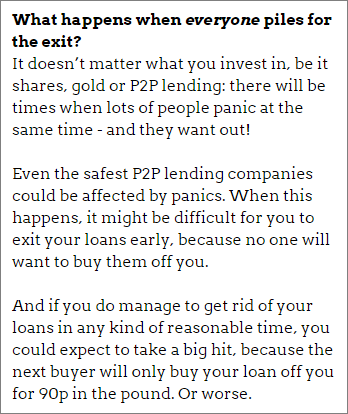 Exiting loans early
Exiting loans early
Quitting a P2P loan is not as simple as withdrawing your savings from your bank. For RateSetter‘s* rolling monthly account, there are no costs when selling your loans at all. For the 1 and 5-year lending accounts, there can be costs.
For all four products, you could sometimes experience delays or difficulties when trying to exit.
The costs
RateSetter has no specific exit charge for 1- and 5-year lending accounts. However, it doesn’t want you to beat the system by allowing you to opt to lend for five years at 6% and then take your money out after 6 months. Otherwise, it is unfair on those lending for around 3% in the rolling monthly account.
Instead, what RateSetter does is repay you less to reflect the interest rates you would have received if you had chosen the shorter lending period.
Next, to get your money back, you need another lender (or lenders) to step in and buy your loans off you. RateSetter has a very smooth system and a large number of lenders. Both these things enable you to leave quickly at RateSetter most of the time. At RateSetter it takes 10 minutes to sell your loans, on average, but there are no guarantees.
Finally, with the 1- and 5-year accounts, since another lender is buying your loan, you might have to make it up to that lender if interest rates at RateSetter are currently higher than the rates you're getting on your own loans.
Let’s say that you lent at 6% but rates have climbed to 7%. To ensure the lender buys in at the rate he/she expects, you might get back a few pounds less to compensate that lender. (The adjustment could be even larger during a recession, when new lenders demand much higher interest rates due to the higher perceived risks.) On the other hand, RateSetter won’t adjust the other way, giving you more money if interest rates have fallen. So you can't profit from your exit.
The average cost of exit in this way has been 0.72%.
Ease of lending
When choosing one or more P2P lending companies to lend through, one key criteria for many individual lenders is how easy it is to lend their money, and to re-lend it when repayments are received.
Enabling this is a major issue for most P2P lending companies and the results are often disappointing, but RateSetter has a lot of new loans each day and there are always lenders who want to exit early, for one reason or another, making it much easier to keep your money on loan most of the time.
Your bank transfers to RateSetter arrive the next day, but payment by debit card usually arrives instantly. Both payment methods are free.
RateSetter, like many P2P lending companies, allows borrowers to repay loans early. Great for the borrowers you're helping, but it can potentially mean more time with your money sitting idle, rather than on loan.
Easily automate your lending or take an income
RateSetter has the most automation options available. You just have a few simple choices to make and then you could leave it all to the P2P lending company to lend and re-lend for you.
You can:
- Automatically lend your money at current interest rates, or at a minimum level you specify (if you’re willing to wait longer).
- Automatically transfer money from your bank account to your RateSetter account for lending. This can also be automatically lent out, if you want.
- Automatically lend any interest and original loan repayments you receive.
- If you prefer, you can automatically lend the original loan repayments but keep the interest.
- Automatically withdraw all the interest and original loan repayments you receive to your bank account.
- If you prefer, you can automatically withdraw just the interest payments, perhaps to supplement your own income.
- Or you can withdraw a fixed amount you specify on a regular basis.
- Automatically sell a portion of your loans. This option still requires you to go into your account, but once you have specified the amount you want to sell in each type of loan you’ve got (e.g. in a 1-year or 5-year loan), RateSetter will then see to it that some of your loans will be sold when other lenders are willing to buy. Indeed, RateSetter has to automate this for you, because you don’t know who your borrowers are at RateSetter.
RateSetter also notifies you by email if you have cash sitting around, e.g. from a repayment or early repayment, and it emails you when money has been lent or re-lent.
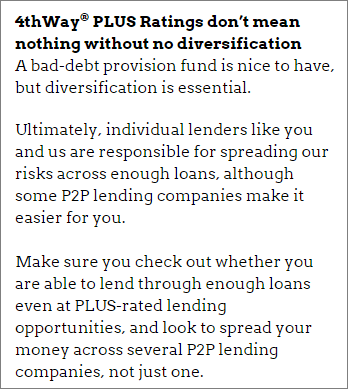 Diversification
Diversification
Diversification at RateSetter is as simple and complete as it gets.
Although you probably lend your money to just a small number of borrowers, the risk of all loans on RateSetter are shared equally between you and all other lenders.
Firstly, for you to suffer bad debts, the entire bad-debt provision fund has to be overwhelmed.
Secondly, if it is overwhelmed, all additional bad debts will be split equally between all existing lenders. Firstly all your interest will be reduced. After that, if a huge number of loans are hit badly, all lenders will share the cost; for example, for each pound all lenders have on loan, each of you might lose 5p. So if you’re lending £1,000 you’ll lose £50. As shown in our PLUS Ratings, we believe that any losses will be recovered swiftly through interest earned, if any losses are made at all.
Combined with RateSetter’s large number of borrowers and lenders, no other P2P lending company offers diversification on this scale.
Borrower selection
You want to see a team that convinces you it is experienced and that it conducts adequate checks on borrowers and their security.
RateSetter has a great team, technology and borrower-rating systems, and it has clearly got a fantastic understanding of which borrowers are genuinely low risk. While most loans are unsecured, that doesn’t matter for RateSetter, which focuses on the quality of the borrower above all else.
Can you select better borrowers?
At RateSetter, you cannot select borrowers yourself. This takes away the fun for many lenders, who want to try and pick better borrowers at higher interest rates – although that is usually very difficult. Other lenders want to know what causes they’re supporting before they lend.
But RateSetter lenders leave the selection entirely to RateSetter and you don't learn who your borrowers are.
Deal-making potential
Since you can’t select borrowers, there is little deal-making potential at RateSetter, so you can never expect to make extraordinary gains through horse trading. The corollary is that you shouldn’t expect extraordinary losses.
Technology
RateSetter uses secure authentication both before and after you log in to your online account. This is a basic, vital safety feature that a surprising number of websites overlook.
We would like to see it use a timed log off It uses a high level of encryption to protect your financial information and a timed log-off to protect you in case you forget to log off yourself.
This is far from the end of RateSetter’s technology security measures. As you’d expect from a leading financial technology company, it uses .NET and ASP.NET, actively maintained firewalls, advanced database encryption, secure data centres and it arranges planned hack attacks from independent experts to try and find weak spots.
Any cash deposits you have at RateSetter are actually with a high-street bank, which has its own security procedures.
Transparency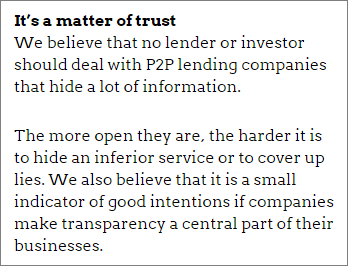
RateSetter does a great job of providing a lot of information to the public and very detailed information to 4thWay. It is constantly improving and adding to the information available, which is very reassuring for lenders. It is one of the most transparent investments we have ever come across.
Skin in the game
As far as we know, like most P2P lending 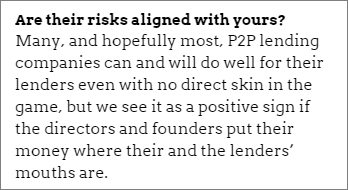 companies (and most other investments for that matter) RateSetter founders do not share lenders' risks directly by lending in all the loans that are matched in its service.
companies (and most other investments for that matter) RateSetter founders do not share lenders' risks directly by lending in all the loans that are matched in its service.
RateSetter earns its fees through the course of the loan, rather than up-front, which aligns its interests in selecting good borrowers slightly better than some other P2P lending companies.
RateSetter also argues that this fee structure encourages more top borrowers to sign up, since up-front fees put them off.
What happens if RateSetter goes bust?
RateSetter is regulated by the UK's Financial Conduct Authority and is a member of the Peer-to-Peer Finance Association.
RateSetter has set up an independent trustee to run down your loans in an orderly fashion if it goes out of business.
Your loans are not protected by the government through the Financial Services Compensation Scheme. If you suffer losses from bad debts, you are not covered any more than you are when you lose money on the stock market.
When your money is not on loan, it will be held in an account at a high-street bank, currently Barclays, and kept separate from RateSetter’s own funds. In the event Barclays fails, this money and all your other deposits at the bank (and other banks in the group that share the same banking licence) are protected by the FSCS up to £85,000.
Financial health
RateSetter turned profitable in early 2013, a little over two years after it began. It often takes a few years for a start-up business to start earning more than it spends. That said, it intends to be loss-making again for several years in order to fund expansion.
It’s latest filed accounts show it's net assets (in particular cash in the bank) swelled to £27 million in 2015 from £7 million the year previously, largely down to cash injections received from investors, including Neil Woodford, the UK's most successful fund manager. Therefore, RateSetter is not just in a leading market position, but well cushioned against disasters for some time to come.
We believe RateSetter can continue to grow quickly at this stage without taking dangerous risks.
Accuracy
There’s always the risk, for all companies, that their information is inaccurate. And we can never be sure that a company is fault or fraud free. However, we have seen no signs to indicate possible significant errors in RateSetter’s numbers or statements.
Costs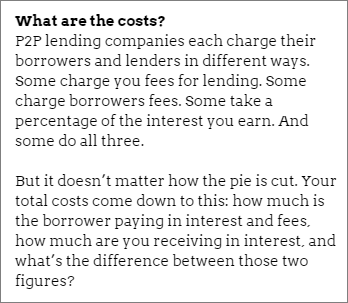
Since you are the lender, the borrower owes you and not RateSetter.
You, in turn, owe RateSetter for managing your own individual little lending “business” for you.
So, although RateSetter charges no lending fees directly, you’re still paying, because you're not receiving everything the borrower pays.
Unfortunately RateSetter, like the majority of P2P lending sites, doesn't give us enough information to estimate the costs for commercial reasons.
Important!
- We do not provide personal financial advice and no opinions expressed on or through this website are to be taken as personal financial advice.
- While we try to be as accurate as possible, we can accept no responsibility for any direct or indirect losses if any information on this website proves to be incorrect.
- It is a big challenge rating investments accurately, not least because we rely on data and information from P2P lending companies and others. That's why, while the 4thWay® PLUS Ratings and Risk Scores are objective measures that we are proud of and are working to improve all the time, they are not infallible.
- There are always additional outside risks that most of us just aren’t rich enough to plan properly for. Crazy as it sounds, maybe there’ll be a nuclear war, anarchy or some other big disaster. We can’t measure such risks, nor can we say whether having your money in a savings account would have been any safer.
See our full terms and conditions of use.
Our service is free to you. We don't receive commission or fees from the above-mentioned companies. We receive compensation from some other P2P lending companies when you click through from our website and open accounts with them, or to cover the costs of conducting our calculated stress tests and ratings assessments. This doesn't affect our editorial independence. Read How we earn money fairly with your help.



